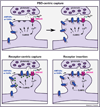AMPARs and synaptic plasticity: the last 25 years
- PMID: 24183021
- PMCID: PMC4195488
- DOI: 10.1016/j.neuron.2013.10.025
AMPARs and synaptic plasticity: the last 25 years
Abstract
The study of synaptic plasticity and specifically LTP and LTD is one of the most active areas of research in neuroscience. In the last 25 years we have come a long way in our understanding of the mechanisms underlying synaptic plasticity. In 1988, AMPA and NMDA receptors were not even molecularly identified and we only had a simple model of the minimal requirements for the induction of plasticity. It is now clear that the modulation of the AMPA receptor function and membrane trafficking is critical for many forms of synaptic plasticity and a large number of proteins have been identified that regulate this complex process. Here we review the progress over the last two and a half decades and discuss the future challenges in the field.
Copyright © 2013 Elsevier Inc. All rights reserved.
Figures




References
-
- Barria A, Malinow R. NMDA receptor subunit composition controls synaptic plasticity by regulating binding to CaMKII. Neuron. 2005;48:289–301. - PubMed
Publication types
MeSH terms
Substances
Grants and funding
LinkOut - more resources
Full Text Sources
Other Literature Sources

